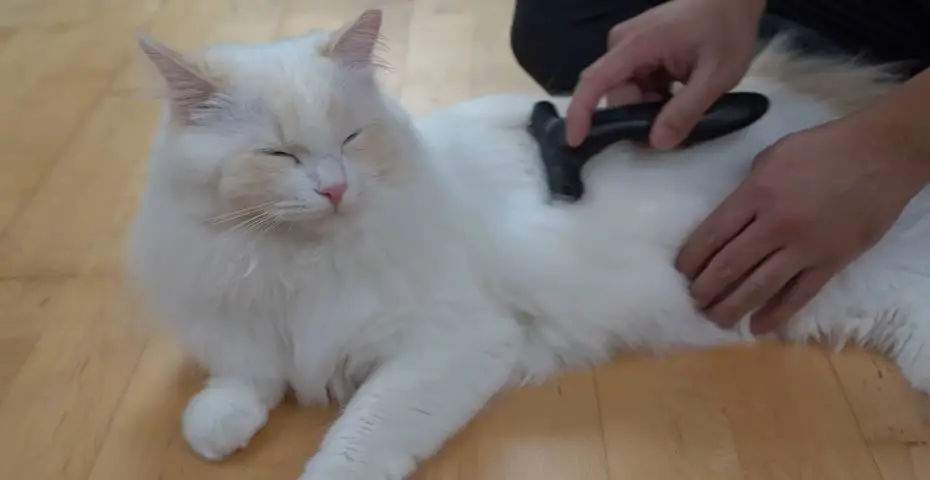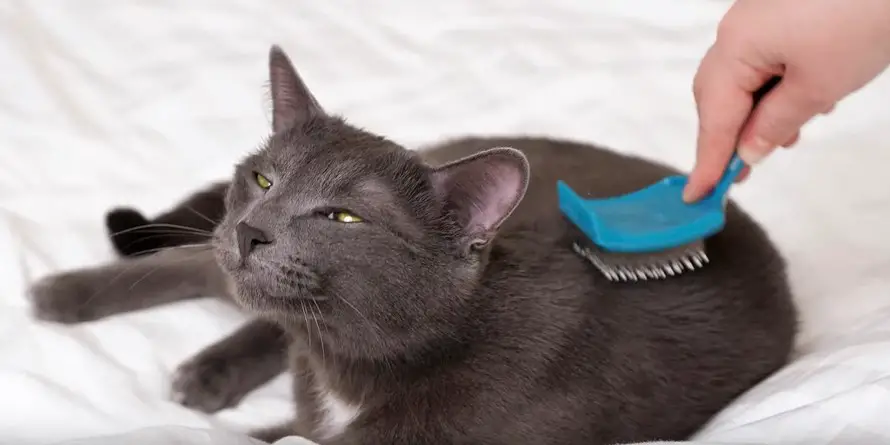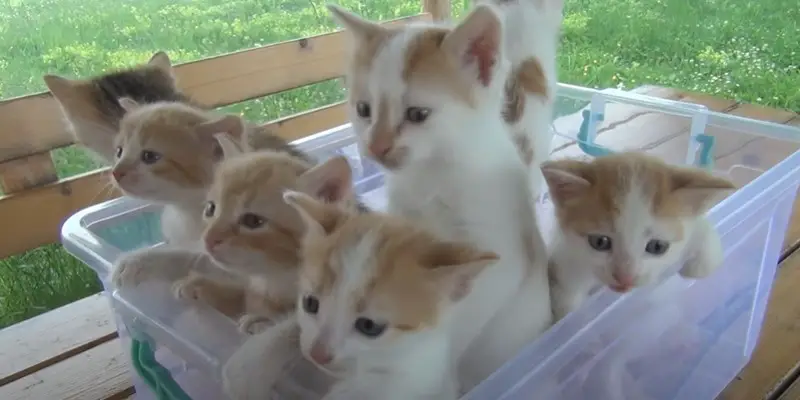Control cat hair in your house by regular grooming and consistent cleaning. Use specific tools like lint rollers and HEPA filters for best results.
Managing cat hair in your home can be a challenge for any pet owner. The key lies in establishing a routine that combines thorough grooming of your feline friend with strategic house cleaning.
Brushing your cat routinely minimizes shedding, while vacuuming with a HEPA-filter-equipped cleaner can capture stray hairs before they settle.
Investing in washable furniture covers or throws also makes it easier to keep surfaces hair-free. Keeping your living space clean and cat hair under control requires dedication, but a systematic approach will significantly reduce the presence of pet hair and maintain a cleaner, fresher home environment.
What is Cat Hair And Shedding
If you’re a cat owner, you’re undoubtedly familiar with finding cat hair on your clothes, furniture, and almost every surface in your home. Cat hair and shedding are natural processes; by grasping the basics, you can manage your feline friend’s loose hair more effectively.

The Basics Of Feline Hair Growth And Shedding
Cats have a distinctive hair growth cycle that involves growth, rest, and loss phases. This cycle ensures that they constantly renew their fur to maintain insulation and protection. Typically, cats will shed more in the spring and fall, responding to changes in daylight and temperature, which naturally triggers hair growth or loss.
- Phase 1: Anagen – The active growth of hair.
- Phase 2: Catagen – The transitional phase where growth stops.
- Phase 3: Telogen – The resting phase before the hair falls out.
Factors Influencing Shedding Intensity
Several factors can cause variations in the amount a cat sheds. Diet, overall health, and breed all play significant roles. Cats on a well-balanced diet with the right nutrients may have healthier coats that shed less. Stress and illness can also lead to increased shedding, as can the change of seasons.
| Factor | Impact on Shedding |
|---|---|
| Nutrition | High-quality nutrition can lead to less shedding. |
| Health | Health issues may increase hair loss. |
| Season | Typically, shedding increases in spring and fall. |
Recognizing The Difference Between Normal Shedding And Health Issues
Understanding the difference between typical shedding and signs of a health problem is crucial. Normal shedding is evenly distributed and consistent with your cat’s shedding history. Excessive shedding, bald patches, or skin irritation could indicate health concerns that require a vet’s attention.
Look for the following signs that differentiate normal shedding from potential health issues:
- Sudden increase in shedding.
- Bald spots or visible irritation on the skin.
- Changes in the coat’s texture or shine.
Immediate veterinary consultation is advisable if any of these symptoms arise, to rule out allergies, parasites, or more serious medical conditions.
Also Read: Can Hairballs Cause Weight Loss in Cats?
Strategies For Minimizing Cat Hair At Home
Living with cats means embracing their companionship along with accepting the furry tumbleweeds that might grace your floors and furniture. If you’re finding cat hair to be your new glitter—appearing in every nook and cranny of your home—fret not.
Implementing strategic measures can significantly minimize the cat hair situation. From routine grooming to nutritional tweaks, here’s how you can keep those fluffy fibers under control and enjoy a cleaner, hair-free space.
Routine Grooming Techniques To Reduce Shedding
Consistent grooming is key to managing your feline friend’s shedding. A regular grooming schedule not only keeps your cat’s coat healthy and shiny but also reduces the amount of hair that ends up on your living room couch. Let’s brush up on some effective grooming techniques:
- Brushing: Allocate time every week to brush your cat’s fur. This not only removes excess and loose fur but also stimulates blood circulation, which improves the coat’s health.
- Bathing: While cats are self-cleaning, an occasional bath can help control shedding. Use a cat-friendly shampoo and ensure a thorough rinse to prevent skin irritations.
- Professional Grooming: For long-haired breeds or cats that shed excessively, consider professional grooming services for a trim or a de-shedding treatment.
The Best Tools For Managing Cat Hair – Brushes And Combs

The market is flooded with grooming tools claiming to be the best, but knowing the right ones makes all the difference. A good grooming tool adapts to your cat’s coat type and grooming needs. Here are some of the top contenders:
| Tool Type | Description | Best Use |
|---|---|---|
| Slicker Brushes | Features fine, short wires close together on a flat surface | Great for removing mats and tangles in medium to long fur |
| Bristle Brushes | Has soft bristles – perfect for short-haired or sensitive cats | Smooths the coat and adds shine |
| De-shedding Tools | Has a fine-toothed metal comb that reaches the undercoat | Effective for reducing shedding in breeds with thick undercoats |
Nutritional Approaches To Control Shedding
Diet plays a pivotal role in your cat’s overall health, including their coat. High-quality nutrition means healthier fur and less shedding. Let’s nibble on some dietary considerations:
- Omega Fatty Acids: Adding omega-3 and omega-6 supplements can bolster skin health, leading to a sturdier coat with less shedding.
- High-Protein Diets: Ensure your cat’s diet is high in animal protein to support keratin production – the protein that makes up hair.
- Hydration: Access to fresh water is essential. Adequate hydration keeps the skin supple and reduces flaky skin and excess shedding.
- Consultation: Consult with a veterinarian to tailor the diet to your cat’s specific needs, potentially integrating special formulations to reduce excessive shedding.
Keeping Your Home Clean And Cat Hair-free
No matter how adorable our feline friends are, cat owners know all too well the challenge of keeping a home clean and hair-free. Cats shed naturally and their hair can find its way onto every surface in the home.
But don’t worry, combatting the feline fluff is possible with a game plan. Under the principle ‘Keeping Your Home Clean and Cat Hair-Free,’ we’ll explore practical measures that any cat owner can implement.
Prepare to tackle the fur with targeted cleaning techniques, essential supplies, and innovative solutions that will help maintain a pristine living space.
Cleaning Techniques That Work Best For Cat Hair
Cat hair has a way of clinging stubbornly to surfaces, and removing it requires specific strategies. Opting for a multi-layered approach, one can ensure their living space remains delightful and fur-free.
Here are a selection of tried-and-true techniques that tackle cat hair with effectiveness:
- Vacuuming regularly with a high-power vacuum designed for pet hair removal.
- Using electrostatic dust wipes to capture hair on hard surfaces.
- Leveraging rubber gloves to pull hair from upholstery.
- Employing a damp sponge or microfiber cloth to lift hair from delicate areas.
- Considering robot vacuums that can perform daily sweeps to keep hair accumulation at bay.
Read: How to Clean a House That Had Cats?
Must-have Cleaning Supplies And Appliances
To efficiently combat cat hair, the right tools are essential. Here is a list of indispensable items that should be part of any cat owner’s cleaning arsenal:
| Item | Function |
|---|---|
| Vacuums with HEPA Filters | Capture fine particles and allergens. |
| Lint Rollers | Quick fixes on clothing and upholstery. |
| Steam Cleaners | Deep clean and sanitize surfaces. |
| Pet Hair Remover Brush | Effective on clothing and soft furnishings. |
| Robotic Vacuums | Maintain floors with minimal effort. |
Establishing A Cleaning Routine For Upholstery And Bedding
Upholstery and bedding can become hotspots for cat hair. Establish a proactive routine to keep these areas pristine:
- Perform weekly vacuuming of sofas and chairs with an upholstery attachment.
- Wash bedding, including your cat’s bed, bi-weekly in hot water to remove hair and dander.
- Use pet-specific furniture covers for easy cleaning and maintain a ‘no cats’ policy in certain areas.
- Incorporate deshedding tools into your pet’s grooming routine to reduce the amount of hair shed.
Innovative Solutions For Dealing With Cat Hair On Clothing
Finding cat hair on clothing can be frustrating, especially when heading out. Consider these innovative strategies to keep clothes fur-free:
- Keep clothes in a closed wardrobe or container.
- Before washing, use a dryer sheet to loosen the hair in the dryer.
- Invest in a washable lint brush to clean clothes before wearing.
- Store a lint roller near the door for a last-minute touch-up.
- Embrace antistatic spray to reduce the cling of hair on fabrics.
Creating A Cat-friendly Environment That Minimizes Hair Scatter
Living with cats means embracing their presence in every aspect of your home, including contending with their hair. While a fuzz-covered home may seem like an unavoidable side effect of cat ownership, there are strategic ways to minimize hair scatter.
Crafting a cat-friendly environment does more than please your feline friends – it can also significantly reduce the amount of cat hair on your belongings.
Furniture And Fabric Choices To Discourage Hair Adhesion
Choosing the right furniture and fabrics can make all the difference in your fight against cat hair. Opt for materials that are sleek and don’t cling to hairs like leather, microfiber, or tightly woven textiles. These are easier to clean and less likely to trap hair.
- Metal or wooden furniture with smooth surfaces repel hair and are simple to wipe down.
- Avoiding heavy, textured fabrics such as velvet or chenille which are magnets for pet hair.
- Use throw blankets on your couches that are easy to launder frequently.
Designing Spaces That Keep Cat Hair Contained
Allocating certain areas as cat zones can help localize the shedding. These areas should be easy to clean and maintain. Consider placing washable cat beds or cushions in designated spots for your cat to lounge.
Implementing a regular grooming schedule in these zones ensures that loose hairs are picked up before they have a chance to spread throughout your home. Here are steps to create these specialized spaces:
- Choose a low-traffic area to set up a grooming station.
- Equip the area with easy-to-clean flooring, such as laminate or tile.
- Keep grooming tools handy for frequent brushing sessions.
Lifestyle Adjustments That Can Help Control Cat Hair In The Home
Daily habits and routines have a substantial impact on managing cat hair. Consistent grooming, vacuuming, and the use of air purifiers help keep hair levels low.
| Routines | Benefits |
|---|---|
| Regular brushing | Removes loose hair before it sheds. |
| Use of lint rollers | Quickly picks up hair from clothing and soft surfaces. |
| Investing in robotic vacuums | Keeps floors free of hair with minimal effort. |
Integrate these habits into your daily routine for a cat hair-free living environment. It’s all about being proactive rather than reactive.
When To Seek Professional Help To Remove Car Hair
If you’re a cat owner, dealing with cat hair is part of the package—it finds its way into every nook and cranny of your home. A little fur is to be expected, but sometimes, excessive shedding can indicate health problems.
Knowing when to seek professional intervention could not only keep your house cleaner but also keep your feline friend in prime condition.
Let’s delve into the signs that hint at medical concerns, the reasons to consult your vet, and when to bring in the cavalry of professional cleaners.
Identifying When Shedding Is A Sign Of Medical Issues
Cat hair is natural and expected, but excessive shedding can be alarming. It’s important to monitor changes in your cat’s shedding patterns. Look out for bald spots, skin irritation, or a coat that looks significantly thinner.
These could be symptoms of allergies, parasites, stress, or underlying health problems that require immediate attention. If your feline companion is displaying unusual shedding patterns alongside other symptoms like changes in appetite, behavior, or activity, it’s time to consider professional advice.
Consulting A Veterinarian For Severe Shedding
When dramatic increases in shedding are observed, seek veterinary assistance. They can perform thorough examinations and tests to determine if the shedding is due to a medical condition.
Your vet may recommend dietary adjustments, medications, or special grooming tools to address the root cause of the hair loss. Be proactive and schedule an appointment if you notice persistent, abnormal shedding.
Professional Cleaning Services For Extreme Cases
In the rare event that your cat’s shedding is beyond the help of regular grooming and veterinary care, or if it poses an overwhelming cleaning challenge, professional cleaning services might be the solution.
Companies specializing in pet dander and hair removal can deep clean your home, upholstery, and air ducts to minimize the effects of cat hair on your environment.
This can be particularly beneficial for those with allergies. Enlisting professional cleaners ensures a thorough removal of allergens and can make a notable difference in your home’s cleanliness and air quality.
FAQs On How To Control Cat Hair In House
What Are Effective Tools For Cat Hair Removal?
Removing cat hair from your home is more manageable with the right tools. Use lint rollers, pet hair vacuums, and fur-removing brushes. They are designed to pick up hair from furniture, clothes, and carpets effectively.
How Often Should I Groom My Cat To Reduce Shedding?
Regular grooming helps control shedding. Brush your cat 2-3 times a week with a de-shedding tool or comb. This removes loose hair and reduces the amount that ends up around your house.
Can Diet Influence My Cat’s Shedding?
Yes, a cat’s diet can impact shedding. High-quality, balanced diets support healthy skin and fur, which may reduce shedding. Consult your vet for recommendations on food that promotes a healthy coat.
What Home Remedies Can Manage Cat Hair At Home?
Simple home remedies to manage cat hair include using dampened rubber gloves to collect hair from furniture, or creating a DIY tape roller. Clean regularly and wash cat bedding frequently to minimize hair buildup.
Conclusion
Taming cat hair at home may seem challenging, but with the right strategies, it’s manageable. Consistent grooming, proper cleaning routines, and specific tools make a difference. Embrace these tactics to enjoy a cleaner living space and a happier, healthier feline companion.
Remember, patience and perseverance turn a hairy situation into a hair-free home!
His professional interests include humane education, ethics, small animal behavior, and veterinary. As a pet lover from school life, having grown up with two cats and a dog. If he isn’t spending time with his friends and family, Justin enjoys traveling. Learn more about Justin here.

